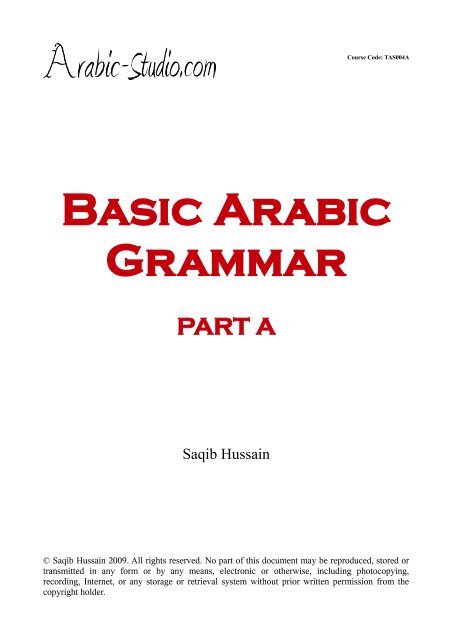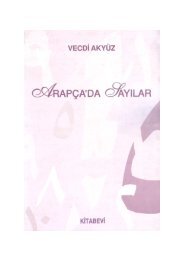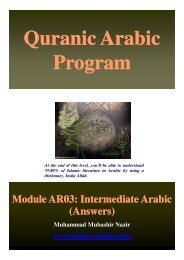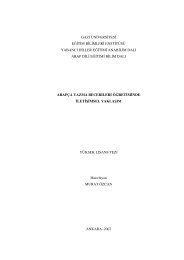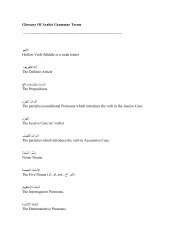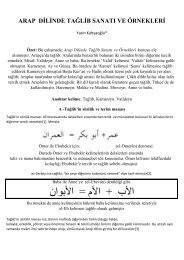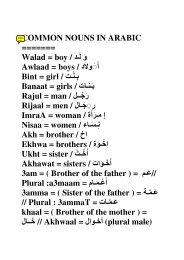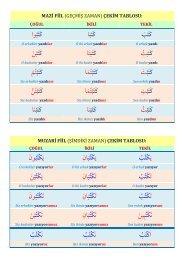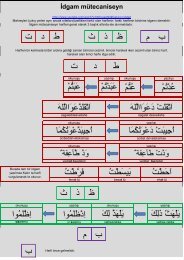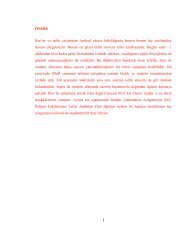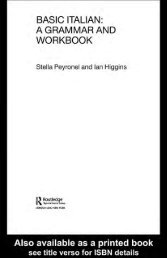Basic Arabic Grammar PART A - gariban tavuk
Basic Arabic Grammar PART A - gariban tavuk
Basic Arabic Grammar PART A - gariban tavuk
Create successful ePaper yourself
Turn your PDF publications into a flip-book with our unique Google optimized e-Paper software.
Course Code: TAS004A<br />
<strong>Basic</strong> <strong>Arabic</strong><br />
<strong>Grammar</strong><br />
<strong>PART</strong> A<br />
Saqib Hussain<br />
© Saqib Hussain 2009. All rights reserved. No part of this document may be reproduced, stored or<br />
transmitted in any form or by any means, electronic or otherwise, including photocopying,<br />
recording, Internet, or any storage or retrieval system without prior written permission from the<br />
copyright holder.
Contents<br />
Introduction...............................................................................................................................2<br />
1 Definite and Indefinite Nouns, and the Nominal Sentence....................................................3<br />
2 Adjectives and Definiteness Agreement..................................................................................9<br />
3 Gender......................................................................................................................................15<br />
4 The Grammatical Cases and Prepositions............................................................................22<br />
5 Verbs - The Perfect Tense.......................................................................................................30<br />
6 Dual Nouns...............................................................................................................................38<br />
7 Plural Nouns............................................................................................................................43<br />
8 The Detached Pronouns and the Irregular Nominal Sentence...........................................51<br />
9 The Imperfect Tense and Negative Verbal Sentences..........................................................56<br />
10 Using verbs and adjectives correctly.....................................................................................61<br />
1
Introduction<br />
This is the first part of a series of four courses (<strong>Basic</strong> <strong>Arabic</strong> <strong>Grammar</strong>: Parts A - D). By the end of<br />
the fourth course students should be able to recognise almost all of the grammatical constructions in<br />
any <strong>Arabic</strong> text, and understand the text with the use of an appropriate dictionary.<br />
This first part focuses on correctly forming basic nominal and verbal sentences.<br />
There are ten video lessons which accompany this textbook. Students will also need the following<br />
texts to derive the maximum benefit from this course:<br />
●<br />
●<br />
<strong>Basic</strong> <strong>Arabic</strong> <strong>Grammar</strong>: Part A - Answer Key<br />
Vocabulary Tickets Pack<br />
This grammar course assumes an understanding of the <strong>Arabic</strong> alphabet and vowel system, and the<br />
basic rules for reading and writing <strong>Arabic</strong>, as covered in the course Reading and Writing the <strong>Arabic</strong><br />
Script (TAS001A).<br />
It is suggested that students work through the ten chapters in this course in the following manner:<br />
1. Read through each chapter;<br />
2. Watch the video lesson for the chapter;<br />
3. Re-read the chapter - you should now have a thorough understanding of the main grammar<br />
points covered;<br />
4. Memorise the vocabulary for the chapter using the Vocabulary Tickets Pack;<br />
5. Attempt all of the translation exercises in writing, and check your answers in the Answer<br />
Key. Make sure you've understood any mistakes that you made.<br />
6. As you work through the textbook, periodically review the translation exercises from prior<br />
chapters until you're able to complete them orally, without hesitation.<br />
Before beginning this grammar course, students should read through the course Introduction to<br />
Learning <strong>Arabic</strong> (TAS003A), which explains how the vocabulary lists are organised, and gives a<br />
vocabulary memorization technique.<br />
2
1 Definite and Indefinite Nouns, and the Nominal Sentence<br />
A<br />
The Noun in <strong>Arabic</strong><br />
<strong>Arabic</strong> nouns are either indefinite or definite.<br />
Indefinite nouns take a tanwīn on their final letter, and are generally translated into English using<br />
the word 'a':<br />
a boy<br />
a book<br />
a man<br />
ولد<br />
كتاب<br />
رجل<br />
To make these nouns definite, we remove the tanwīn and fix the ال word 1 to the beginning of the<br />
word. This is generally translated using the word 'the':<br />
the boy<br />
the book<br />
the man<br />
الولد<br />
الكتاب<br />
الرجل<br />
Unlike in English, adjectives in <strong>Arabic</strong> are also either definite or indefinite, just like the nouns. We'll<br />
come back to this point in the next chapter.<br />
B<br />
The Nominal Sentence<br />
The most basic sentence in <strong>Arabic</strong> is called the nominal sentence. This is of the form 'X is/are Y',<br />
such as 'The boy is tall', or 'The books are big.'<br />
X is usually a definite noun, and is known as the subject. Y is usually an indefinite noun or an<br />
indefinite adjective, and is called the predicate.<br />
This is illustrated below. Note that in <strong>Arabic</strong> we don't have a word for 'is/are' in the nominal<br />
sentence.<br />
3
The Nominal<br />
Sentence<br />
PREDICATE<br />
is/are<br />
SUBJECT<br />
English Example<br />
tall is The man<br />
الرجل طويل <strong>Arabic</strong> Example<br />
Consider the following nominal sentences:<br />
الباب كبير The door is big<br />
الرجل أستاذ The man is a teacher<br />
C<br />
The Singular Detached Pronouns<br />
We can replace the subject of a nominal sentence with a pronoun. For example, rather than saying<br />
'The man is tall', we might want to say, 'He is tall'. The <strong>Arabic</strong> pronouns we use for this replacement<br />
are called the detached pronouns.<br />
Detached pronouns are fully covered in Chapter 8; only the singular forms are given here. Note<br />
there are different words for 'you' in <strong>Arabic</strong> for addressing a male and a female person. We'll<br />
differentiate in English by using SRm (singular masculine) and SRf (singular feminine) in subscript.<br />
I<br />
you SRm<br />
you SRf<br />
he/it 2<br />
she/it<br />
أنا1<br />
أنت<br />
أنت<br />
هو<br />
هي<br />
. أن were: 1 is silent, so it is pronounced as if it أنا of 1 ا 1 The<br />
depending on whether the subject هي or 1 هو 2 Note that there is no separate pronoun for 'it'. Instead, we just use 1<br />
being referred to is masculine or feminine respectively (see Chapter 3).<br />
4
Consider the following sentences:<br />
أنت طويل You SRm are tall<br />
هو قصير He is short<br />
أنا صغير I am young<br />
D<br />
Using 'And' in the Nominal Sentence<br />
The word for 'and' in <strong>Arabic</strong> و is 1 . Its use in the nominal sentence is very intuitive. Consider the<br />
following nominal sentences, each of which has more than one predicate:<br />
كبير<br />
الباب The door is big and beautiful<br />
أستاذ<br />
جميل و<br />
الرجل The man is a teacher and a student<br />
طوي ل<br />
طالب و<br />
الشارع The street is long and wide<br />
'And' can also be used to link two nominal sentences together:<br />
واسع و<br />
كبير البحر The sea is big and the river is small<br />
أستاذ<br />
صغير النهر و<br />
طالب الولد و الرجل The man is a teacher and the boy is a student<br />
جديد الباب و قديم الكرسي7 The chair is old and the door is new<br />
5
Vocabulary<br />
man | PL<br />
boy, son | PL<br />
teacher | PL<br />
student | 2PLS 3<br />
river | PL<br />
sea | 2PLS<br />
book | PL<br />
street | PL<br />
chair | PL<br />
door; chapter | PL<br />
the Nile<br />
big, great | PL 5<br />
small, young | PL<br />
old, ancient | PL<br />
new | 2PLS<br />
long, tall | PL<br />
short | PL<br />
beautiful, handsome | PL<br />
رجل | رجال<br />
ولد | اولد<br />
أستاذ | أساتذة<br />
طالب | طلBب ، طلبة<br />
نهر | أنهار<br />
بحر | بحار ، أبحر<br />
كتاب | كتب<br />
شارع | شوارع4<br />
كرسيG | كراسي7<br />
باب | أبواب<br />
النHيل<br />
كبير | كبار<br />
صغير | صغار<br />
قديم | قدماءI<br />
جديد | جدد ، جدد<br />
طويل | طوال<br />
قصير | قصار<br />
جميل | جمال<br />
3 A single <strong>Arabic</strong> word may have a number of plurals. This is true of a few English words too (e.g. the plurals of<br />
antenna are antennas and antennae, the plurals of fungus are fungi and funguses), but is much more common in<br />
<strong>Arabic</strong>.<br />
4 Notice that unlike most of the other words here, 1 شوارع doesn't have a tanwīn ending. Such words are called<br />
diptotes, and will be covered in <strong>Basic</strong> <strong>Arabic</strong> <strong>Grammar</strong>: Part B. For now, treat such words like any other, except<br />
that they must never have a tanwīn ending. You will also encounter other odd-looking plurals in the vocabulary<br />
lists (e.g. 1 أراضL in Chapter 3 and 1 قرOى in Chapter 10); these words should of course be learnt, but will be dealt<br />
with in <strong>Basic</strong> <strong>Arabic</strong> <strong>Grammar</strong>: Part B.<br />
5 Many <strong>Arabic</strong> adjectives have plurals. This is needed for agreement between nouns and adjectives (see Chapter 7).<br />
6
oken<br />
broad, wide<br />
مكسور<br />
واسع<br />
Translation Exercises<br />
Exercise 1A<br />
رجل و ولد.<br />
الIستاذ و الطBالب.<br />
الIستاذ جديد.<br />
أنا طويل.<br />
النHيل قديم.<br />
النHيل نهر.<br />
البحر كبير.<br />
الباب قديم و مكسور.<br />
الكتاب قديم و جميل.<br />
الطBالب صغير. هو قصير.<br />
الكرسي7 طويل. هو جميل.<br />
الولد صغير و جميل.<br />
الباب كبير و واسع و جميل.<br />
أنت رجل و أنا ولد.<br />
الشارع جديد و قصير و النهر قديم و طويل.<br />
١<br />
٢<br />
٣<br />
٤<br />
٥<br />
٦<br />
٧<br />
٨<br />
٩<br />
١٠<br />
١١<br />
١٢<br />
١٣<br />
١٤<br />
١٥<br />
Exercise 1B<br />
1. The river and the sea.<br />
2. A book and a chair.<br />
3. The street is long.<br />
4. He is a boy.<br />
7
5. The Nile is ancient.<br />
6. I am a student and you SRm are a teacher.<br />
7. The door is tall.<br />
8. The sea is small and beautiful.<br />
9. The door is beautiful. It is big.<br />
10. The boy is young and short.<br />
11. The man is big and the boy is tall.<br />
12. You SRm are tall and he is short.<br />
13. The chair is big, old and broken 6 .<br />
14. The teacher is tall and the student is short.<br />
15. The book is small and new, and the chapter is short and beautiful.<br />
و 6 This should be translated as if it were: 'The chair is big and old and broken.' As a general rule, in <strong>Arabic</strong> we use 1<br />
to separate items in a list like the three predicates in this example, where in English we would use commas.<br />
8
2 Adjectives and Definiteness Agreement<br />
A<br />
Adjectival Agreement<br />
There are two things we must remember about adjectives in <strong>Arabic</strong>:<br />
Firstly, they come after the nouns that they describe, unlike in English, where they occur before the<br />
nouns. So, whereas in English we would say 'a narrow sword', in <strong>Arabic</strong> we say 'a sword narrow':<br />
. سيف ضيHق 1<br />
Secondly, the adjective must agree with the noun it describes in four ways:<br />
1. Definiteness<br />
If the noun is definite, its adjective must also be definite; if the noun is indefinite, its<br />
adjective must also be indefinite.<br />
2. Gender<br />
[See Chapter 3]<br />
3. Case<br />
[See Chapter 4]<br />
4. Number<br />
[See Chapters 6 and 7]<br />
This chapter will focus on definiteness agreement. Consider the following phrases, in which the<br />
adjectives agree with their nouns in being definite or indefinite:<br />
a narrow sword<br />
the narrow sword<br />
a clean cup<br />
the clean cup<br />
a narrow, ugly, dirty house<br />
سيف ضيHق<br />
السيف الضيHق<br />
فنجان نظيف<br />
الفنجان النظيف<br />
بيت ضيHق قبيح وسخ<br />
9
البيت الضيHق القبيح الوسخ the narrow, ugly, dirty house<br />
Note that when there is a series of adjectives, as in the last two examples, each one must agree with<br />
its noun in the four ways described above.<br />
B<br />
Adjectives in the Nominal Sentence<br />
We can now make our nominal sentences more sophisticated, by giving the subject and/or the<br />
predicate their own adjectives. This is illustrated below:<br />
The Nominal<br />
Sentence<br />
(with adjs)<br />
PREDICATE<br />
+ ADJ.<br />
is/are<br />
SUBJECT<br />
+ ADJ.<br />
English Example a good doctor is The tall man<br />
طبيب حسن <strong>Arabic</strong> Example<br />
الرجل الطBوي ل<br />
Consider the following sentences:<br />
البيت الضيH ق نظيف The narrow house is clean<br />
الستاذ الحسن قصير The good teacher is short<br />
القبيح حار% و وسخ<br />
البستان The ugly garden is hot and dirty<br />
C<br />
Forming Questions<br />
By putting the هل particle 1 or the أ particle 1 in front of a statement, we turn that statement into a<br />
question:<br />
أنت طويل You SRm are tall<br />
Are you SRm tall?<br />
هل أنت طويل ؟<br />
10
هو قصير He is short<br />
Is he short?<br />
أ هو قصير ؟<br />
البيت الضيHق نظيف The narrow house is clean<br />
هل البيت الضيHق نظيف ؟ ? 7 Is the narrow house clean<br />
الIستاذ الحسن قصير The good teacher is short<br />
هل الIستاذ الحسن قصير ؟ short? Is the good teacher<br />
In response to such questions, the word for 'yes' is 1 . ل , and the word for 'no' is 1 نعم<br />
Questions are fully covered in Chapter 19.<br />
7 When we put the هل particle 1 in front of a word which begins with a connecting hamzah, such ال as 1 , we<br />
encounter the double-sukūn problem: the ل هل of 1 and the ل ال of 1 both have a sukūn, and they are consecutive<br />
letters (remember, we're ignoring the connecting hamzah). To make the word pronounceable, we have to give the<br />
first ل a kasrah, which turns it into: 1 هل . This is the default way to avoid double-sukūns: change the first sukūn to<br />
a kasrah.<br />
11
Vocabulary<br />
بستان | بساتين garden | PL<br />
حجر | أحجار stone | PL<br />
بيت | بيوت house | PL<br />
حائط | حيطان wall | PL<br />
قلم | أقلم pen | PL<br />
فنجان | فناجين cup | PL<br />
صحن | صحون plate | PL<br />
درس | دروس lesson | PL<br />
سيف | سيوف sword | PL<br />
نظيف | نظفاءI clean | PL<br />
dirty<br />
وسخ<br />
حسن | حسان good, beautiful | PL<br />
bad, wicked<br />
سيHئ<br />
قبيح | قباح ugly | PL<br />
شديد | شداد hard, strong, powerful [thing]; stern [person] | PL<br />
بعيد | بعداءI distant | PL<br />
حاضر | حضور present | PL<br />
narrow<br />
hot<br />
ضيHق<br />
حارG<br />
ميHت | أموات dead | PL<br />
12
Translation Exercises<br />
Exercise 2A<br />
الدرس القصير.<br />
هل الولد حاضر؟ نعم، أنا حاضر و هو حاضر.<br />
القلم القديم.<br />
صحن صغير.<br />
البستان النظيف بعيد.<br />
هل الفنجان الحار7 مكسور؟ نعم، هو مكسور.<br />
البيت القبيح ضيHق.<br />
النHيل نهر واسع. أ هو طويل؟ نعم، هو طويل.<br />
أ أنت ولد حسن؟ نعم، أنا ولد حسن.<br />
الIستاذ رجل ميHت.<br />
السيف الجديد الطBويل وسخ. أ هو مكسور؟<br />
الحجر الكبير الشديد جميل.<br />
هل الطBالب ولد سيHئ قبيح؟ ل، هو حسن.<br />
الرجل أستاذ جميل طويل.<br />
الحائط الشديد القديم ضيHق و قصير.<br />
١<br />
٢<br />
٣<br />
٤<br />
٥<br />
٦<br />
٧<br />
٨<br />
٩<br />
١٠<br />
١١<br />
١٢<br />
١٣<br />
١٤<br />
١٥<br />
Exercise 2B<br />
1. A good lesson.<br />
2. The long wall.<br />
3. A broken pen.<br />
4. The hot stone.<br />
5. Is the new chair dirty? No, it is clean.<br />
6. The strong door is narrow.<br />
7. The big garden is far.<br />
13
8. The teacher is a man. He is a small man.<br />
9. Is the Nile a sea? No, it is a big river.<br />
10. The beautiful student is dead.<br />
11. The old house is ugly and the short street is bad.<br />
12. The big wide cup is clean and new.<br />
13. The ugly old book is long and bad.<br />
14. The beautiful, distant sea is hot and powerful.<br />
15. The good, small sword is dirty and broken.<br />
14
For the complete textbook,<br />
please visit<br />
www.arabic-studio.com


